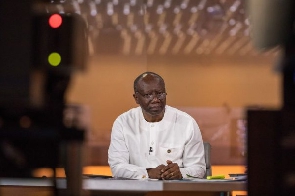 Finance Minister, Ken Ofori-Atta
Finance Minister, Ken Ofori-Atta
Total wages and salaries of public sector workers will rise by 7.0 percent to GH¢28.5 billion in 2021, according to the 2021 Fiscal Framework of the Ministry of Finance.
This is equivalent to 6.5 percent of Gross Domestic Product. Compensation of employees for 2020 is estimated at GH¢26.6 billion, about 6.9 percent of revised GDP in 2020.
This is expected to increase to GH¢32.5 billion (6.5 percent of GDP), GH¢35,829 million (6.3 percent of GDP), and GH¢40,129 million (6.3 percent of GDP) in 2022, 2023, and 2024, respectively.
Goods and Services is however projected at GH¢7.0 billion (1.6 percent of GDP) in 2021, increasing to GH¢8.8 billion (1.8 percent of GDP) and GH¢10.8 billion (1.9 percept of GDP) in 2022 and 2023 respectively.
Total revenue and grants is projected at GH¢56.9 billion (13 percent of GDP) for 2021, based on the 2021 fiscal framework, and represents a nominal growth of 9.7 percent over the revised target for 2020.
Also, total expenditure including payments for the clearance of arrears is projected at GH¢98.4 billion (28.2 percent of GDP) in 2021, GH¢103.4 billion (29.6 percent of GDP) in 2022, and GH¢116.8 billion (33.4 percent of GDP) in 2024.
The combined resources available for Goods and Services and Domestically Financed CAPEX will also amount to GH¢11 billion (2.5 percent of GDP) in 2021, to GH¢14.2 billion (2.8 percent of GDP) in 2022 and GH¢25.9 billion (4.1 percent of GDP) by 2021.
The framework also projected a fiscal deficit on cash basis at GH¢41.5 billion (9.4 percent of GDP) in 2021.
It will decline further to GH¢32.1 billion (6.4 percent of GDP) in 2022, GH¢27 billion (4.9 percnet of GDP) in 2023 and further to GH¢20.4 billion (3.2 percent of GDP) by 2024.
The main thrust of macroeconomic policy in 2021 will focus on ensuring stabilisation and returning the economy to the pre-pandemic fiscal stance; whilst restoring economic growth to pre-pandemic growth path while protecting social spending.
Also, the broad macroeconomic objectives will support the medium-term goal to stabilize, revitalize, and transform the economy whilst ensuring restoration and sustainability of macroeconomic stability, amongst others.
Amid COVID-19, Ghana’s economy is forecast to grow between 1.8 and 2 percent in 2020.